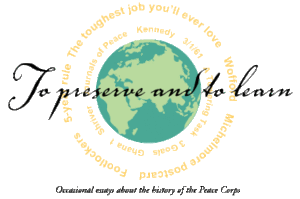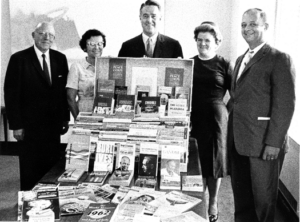The Fabulous Peace Corps Booklocker
 The Fabulous Peace Corps Booklocker
The Fabulous Peace Corps Booklocker
by Jack Prebis (Ethiopia 1962–64)
For a short period of time in the very first years of the Peace Corps all Volunteers were given booklockers by the agency. The lockers were meant to provide leisure reading for the PCVs and then to be left behind in schools, villages, and towns where they served. There is some mystery as to who first thought of the lockers and one rumor has it that the idea came from Sarge Shriver’s wife, Eunice.
It is believed that the books were selected for the first locker by a young Foreign Service officer. A second selection was done in 1964, and that same year Jack Prebis was made responsible for the 3rd edition of the locker that was assembled in the fall and winter of 1965. JC
DEVELOPING THE Peace Corps booklocker was the best job I ever had. As sometimes happens with fun jobs, this one fell in my lap. Returning in 1964 from my secondary school teaching stint in Ethiopia, I headed to Our Nation’s Capital, hoping to land stateside Peace Corps work. Back in those days, the Peace Corps was fresh, free-wheeling and unbureaucratic, shot through with idealists. (Thanks in part to the five-year rule, it remains staffed with idealists.)
To my good fortune, as I was being interviewed — was it by fifteen people? — the person who had been working on “the booklocker” was heading to Chile on staff. My biology major and chemistry minor seemed perfect for the unexpected vacancy.
After dispatching a mile-high stack of unanswered mail from publishers wanting to donate their remaindered titles (we already had a warehouse full of books totally unsuited to host country needs, aspiration and mores), I got down to my major function — feet on desk, reviewing paperbacks for inclusion in the next booklocker.
What power! Aside from deciding what Volunteers and their friends would be reading over the next few years, with 4,000 footlockers to fill with 250 books each, I soon learned I wielded some influence. It was tough resisting the offers of free trips to New York City and attendant free lunches. But I learned quickly that publishers often were happy to do press runs of hardback or out of print titles if they had a guaranteed 4,000-book sale. With that bit of knowledge, I obtained such titles as The Palm-Wine Drinkard by Amos Tutuola and Blossoms in the Dust: The Human Factor in Indian Development by Kusum Nair [available used from Amazon].
I also learned that my English-Literature- major friends had something concrete to offer (as opposed to being skilled Botticelli players). They were more than happy to help review contemporary titles and offer suggestions on the classics — with never a consensus on either, I might add.
But eventually, I developed a good mix of fiction (over half the books) and other sections like “American Studies” and “African—or LA or NANESA [North Africa, Near East, South Asia], Studies” depending on the destination. Debated along the way: Was Henry Ford a suitable example of American industrialization and the free enterprise system? (More or less). Or, would Ayn Rand stimulate depression and early terminations? (One couldn’t be too careful.)
There were clearance hurdles I had not anticipated with the State Department and USIA. After some concessions on their part over a few titles, there remained two objections: No Exit [an existential play by Jean Paul Sartre] and Catch 22 by Joseph Heller. Finally, I agreed that we didn’t need to export the Communist line, but contended that Catch 22, in spite of depicting the U.S. military in a less-than-complimentary light, likely would not get wide distribution among host country nationals, but would be good escape reading on quiet nights. And so it was.

What a great job!!
As a volunteer beginning in 1968 in Kenya, my housemates and I inherited several book lockers. Truly that’s what filled down time. One Sunday I read five books! Thanks for making that possible.
Jack,
It was through that Foot Locker of Books that got me through many a night of uncertainty as to what in God’s good name was I doing in this village of some 3,000 on the foothills of the Andean Mountains with tenuous language skills and not a single official having ever having requested a Volunteer to help them develop ag cooperatives! Still, it was where I found Marcel Proust and a Remembrance of Things Past and T. E. Lawrence’s the Seven Pillars of Wisdom that got me into the next day–and all those wonderful days of meaning and purpose thereafter.
While I was a big fan of the booklocker in Tanzania in 1965-66, it could also play a more dramatic role. In some ways it is in the center of my non-fiction book, “Ever Hill a Burial Place: The Peace Corps Murder Trial in East Africa.” The prosecution used excerpts from the Wright Morris book, “Ceremony In Lone Tree” as the basis for a charge of murder.
https://www.peterreidwriter.com
Question: Was the “Remote Areas Development Manual” in our book lockers? Or was this something issued Rural Development Volunteers by Peace Corps or CARE?
It was in our book locker in Ethiopia in 1966
I inherited a book locker in 1969 in Ghana. It was a wonder. Some of the books I read included The Hobbit and The Lord of the Rings trilogy. They were my evening’s entertainment. When I finished my service, I continued the tradition of passing the locker to the next volunteers in my town.
Kudos to creating this article. We have received much interest in the book lockers at the Museum of the Peace corps Experience. I will happily refer them to this article! Very interesting, and the comments too.
I always liked reading books but during my two years in the Andes of Peru (1964-66) I read books in fields outside my college psych-sociology major. Books in economics, political theory, history, and even fantasy opened my eyes to many subjects that I’d never before have been tempted to read. I can’t remember the specific titles, but I recall that I loved devouring anything available to read in English. That might be why I decided to write my own books later–mostly memoirs of my time in (Between Inca Walls) and after the Peace Corps (Love in Any Language). Thanks, book locker.
We had the book locker, but I don’t remember any serious books. Most of us read Catch 22 during training and Mark Twain’s Notes from the Underground. In the foot locker, we had a lot of mystery books and Dr. Spock, which was really helpful. I remember a novel callled The Fun House, which was about an ad agency. We would add “on the Potomac” to speak about PC/Washington.
We were in a very conservative community. We did not share the books because we were not sure how they might be received.
You Know interestingly enough, as a volunteer in 1962, I thought the book locker was a real treasure (and we should also give homage to our Peace Corps Medical kits) and was looking forward to reading through it. As it turned out, I was so busy that I didn’t have time to read. By the time I got back to my site every night, it fell into bed. I remember reading only one book and it was not in the foot locker, Seven Days in May. Don’t know where I got it but I was really counting on catching up on my reading, I even brought some Shakespeare because I missed it at some point in my studies. But it was a great thought and let me add the thing i did read every week was the New York TimesWeek in Review that we received at our post office box in the town nearest to us. It was a way to stay connected with what was happening in the US and around the world. Great nostalgia.
I loved my book locker, especially Amos Tutuola!
Do you have a list of the books in the locker?
Thanks,
ge Tunisia 1964-66
From the comment here, I don’t think all the book lockers had the same books.